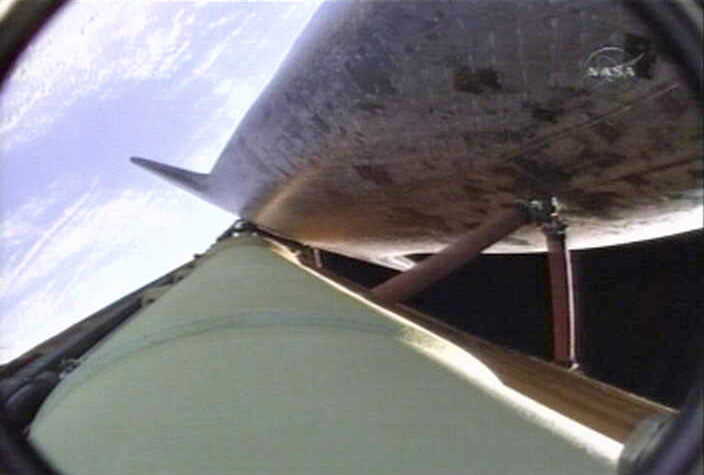Hubble-Bound Astronauts Inspect Shuttle for Damage

Thisstory was updated at 12:51 p.m. EDT.
CAPE CANAVERAL,Fla. - Astronauts aboard the space shuttle Atlantis inspected theirspacecraft?s vital heat shield for damage Tuesday while en route to the HubbleSpace Telescope to perform one last service call.
Thespaceflyers used an inspection pole tipped with laser sensors and cameras toseek out any dings in the heat-resistant panels lining the spacecraft?s wingedges and nose.
Theshuttle?s heat shield health will be a key concern for NASA throughout therisky mission to overhaulHubble. The space agency has put the shuttle Endeavour on standby to fly arescuemission to retrieve the Atlantis astronauts if their spacecraft is damagedbeyond repair.
Atlantisand its crew of seven astronauts launched toward Hubble on Monday to beginNASA?s fifth and final mission to the 19-year-oldspace telescope. After the successful liftoff, NASA technicians were surprisedto find damage at the launch pad from the fiery blast of the shuttle?s rocketengines, agency officials said.
Atlantis isdue to arrive at Hubble on Wednesday and is about 8,000 miles (12,874 km) andclosing on the telescope. The astronauts plan to perform five consecutivespacewalks to add two new cameras, repair two other instruments never designedto be repaired in space and perform other maintenance.
Shuttlelooks good
Get the Space.com Newsletter
Breaking space news, the latest updates on rocket launches, skywatching events and more!
Some piecesof debris were spotted falling from the shuttle?s external tank and boosters duringlaunch, but none of the pieces appeared to cause any damage, NASA officialssaid.
?They?revery minor from what we could observe,? NASA?s space operations chief BillGerstenmaier said after launch.
NASA haskept a close watch on shuttle heat shield health since 2003, when a piece offuel tank foam struck the Columbia orbiter?s wing and led to its destructionand the loss of seven astronauts. Now, astronauts inspect their shuttle heatshield twice on every mission.
Today,Atlantis commander Scott Altman and his crew conducted extended version of heatshield scans used on missions bound for the International Space Station. Thescan is one of two to make sure Atlantis is not damaged by launch debris orspace junk.
The areaaround Hubble?s 350-mile (563-km) orbit is littered with space trash, givingAtlantis a slightly higher chance of being struck by debris or micrometeorites,NASA officials have said. But the risk is still within NASA?s acceptablelimits, they added.
Back onEarth, NASA technicians are evaluating the damage to Atlantis? launch pad causedwhen the shuttle blasted off Monday. The damage was spotted in the pad?s flametrench, which funnels rocket engine exhaust away from a shuttle during liftoff.
Somenitrogen and pressure lines were damaged, as well as a 25-square-foot sectionof the heat-resistant coating that covers the bricks beneath the launch pad,NASA spokesperson Allard Beutel told SPACE.com. The damage is lesssevere than that seen during a launch last year, and can be repaired in timefor NASA?s next mission in June, he added.
Marathoninspection
Today?sshuttle survey will take nearly 10 hours to complete - about twice as long asnormal - because the Atlantis crew must inspect the thousands of black,heat-resistant tiles covering the spacecraft?s underbelly. On missions to thespace station, the same area is covered in photographs taken by astronautsinside the orbiting laboratory while the shuttle performs an orbital back flipnearby.
?What we?veadded for this flight is a belly tile survey,? said shuttle flight director TonyCeccacci, adding that Atlantis astronauts will go nearly nine hours without abreak to cram the extended survey into an already tight schedule. ?Usually, ina station flight, you break that up with a meal, we don?t have that luxury withthe timeline.?
Atlantisastronauts used the shuttle?s robotic arm to inspect the outside of the crewcabin and cargo bay. To see the hard-to-reach spots on Atlantis? belly,astronauts will reach under the spacecraft with the 50-foot (15-meter)inspection pole, which double?s the length of the shuttle?s robotic arm.
Missionspecialist Megan McArthur, Atlantis? roboticarm expert, will lead the inspection work, but the long job will be sharedamong the entire crew. The chore, she said, is not too different than thoseused on station-bound shuttle missions, just longer.
?They?re verysimilar, so it?s a very well understood operation,? McArthur said.
SPACE.comis providing continuous coverage of NASA?s last mission to the Hubble SpaceTelescope with senior editor Tariq Malik at Cape Canaveral and reporter ClaraMoskowitz in New York. Clickhere for mission updates and SPACE.com's live NASA TV video feed.
- New Video Show - Hubble's Final Shuttle Service Call
- New Video - The Hubble Rescue Mission Revealed
- Image Gallery - Hubble?s Latest Views of the Universe: Part 1, Part 2
Join our Space Forums to keep talking space on the latest missions, night sky and more! And if you have a news tip, correction or comment, let us know at: community@space.com.

Tariq is the Editor-in-Chief of Space.com and joined the team in 2001, first as an intern and staff writer, and later as an editor. He covers human spaceflight, exploration and space science, as well as skywatching and entertainment. He became Space.com's Managing Editor in 2009 and Editor-in-Chief in 2019. Before joining Space.com, Tariq was a staff reporter for The Los Angeles Times covering education and city beats in La Habra, Fullerton and Huntington Beach. In October 2022, Tariq received the Harry Kolcum Award for excellence in space reporting from the National Space Club Florida Committee. He is also an Eagle Scout (yes, he has the Space Exploration merit badge) and went to Space Camp four times as a kid and a fifth time as an adult. He has journalism degrees from the University of Southern California and New York University. You can find Tariq at Space.com and as the co-host to the This Week In Space podcast with space historian Rod Pyle on the TWiT network. To see his latest project, you can follow Tariq on Twitter @tariqjmalik.









